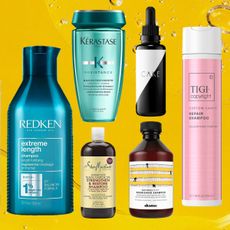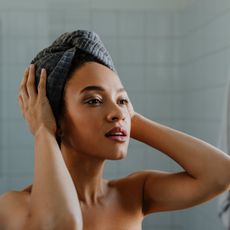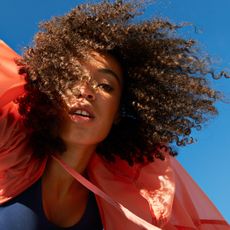When French girls turn 13, we get a training bra and our first visit to the aesthetician to learn how to take care of our skin," says Laetitia Labassee, director of education for the Paris-based skincare company Darphin. Perhaps this rite of passage supports the bold claim made in the recently released book French Women Don't Get Facelifts by former Clicquot Inc. CEO Mireille Guiliano. But where does that leave the rest of us who haven't been getting weekly facials since junior high? Is a future face-lift inevitable? Not at all. In fact, some doctors believe the procedure could be passé by the time 20- and 30-somethings hit their 50s. "With today's noninvasive treatments and women who are more savvy about their skincare and wellness options, face-lifts may be unheard of in 20 years," says Dr. Joshua Zeichner, director of cosmetic and clinical research for the department of dermatology at Mount Sinai Hospital in New York City. Read on to learn how to combine the best of French techniques (healthy lifestyle habits, tricks from experts) and some American ingenuity (noninvasive cosmetic procedures) so you can look amazing longer.
STICK IT TO WRINKLES NOW
You've probably heard that Botox, Dysport, and Xeomin relax wrinkles (with results that last about four months), but it turns out they also weaken muscles over time, so creases like those brow 11s don't get deeper—and in some cases, don't even appear. "If you slow down the use of these muscles beginning early in adult life, the lines may never develop," explains Dr. Kenneth Arndt, a clinical professor of dermatology at Harvard Medical School and the coauthor of a recent commentary published in the journal JAMA Dermatology that addresses this very topic. That doesn't necessarily mean you should dash out for Botox tomorrow, but it may be worth discussing with a doctor when wrinkles are still faint. Arndt offers the example of one patient who got Botox regularly starting at 25; she's now 38 and has no creases between her brows, while her twin sister (who only got Botox twice during the same period) does. "There is rarely a time that is too early," Arndt noted in his commentary. "Perhaps a better question is, When is too late?"
FILL 'ER UP
Hyaluronic acid fillers such as Juvéderm and Restylane add fullness to your face and plump out lines so they're less noticeable for six to 12 months; the newly FDA-approved filler Voluma lasts even longer. "Voluma is not only able to restore lost volume but also lifts the skin as well, and clinical studies have shown results can last up to two years," explains Dr. Fredric Brandt, a dermatologist based in Miami and New York City. Although fillers may have been designed for quick results, researchers have found they can also have a long-term effect. Another study published in JAMA Dermatology shows hyaluronic acid fillers may lead to collagen growth and stimulate the production of chemicals that prevent the breakdown of existing collagen. In short, a few subtle injections of filler every year can nudge you ahead of the game decades from now, even if you eventually stop treatments and go au naturel.
GIVE YOURSELF A MASSAGE
Working out tones muscles so your body looks firmer, and many experts believe the same holds true for your face. "Aestheticians at the Darphin Paris Institute teach women to apply their face creams with a deep massaging motion," Labassee explains. "Think of it as Pilates for your face." Women in Korea and Japan are also fans of facial massage, she says. The key is to take your time when you put on moisturizer. Start by pressing the heels of your hands along your jawline on both sides of your face, moving up toward the ears. Next, use fingertips to smooth on your cream from the apples of cheeks up and back toward the temples, then from the brows up toward the hairline.
SLEEP RIGHT
Over time, the "sleep wrinkles" caused by mushing your face against a pillow each night won't disappear once you're awake. If you sleep on your stomach, "the compression between the pillow and your skin can cause lines around the eye area that are more distinct than the usual lines caused by aging," says Dr. Julia Tzu, a dermatologist and clinical assistant professor of dermatology at New York University School of Medicine. And side sleepers "can get prominent lines on the side that rests against the pillow, increasing the number of horizontal neck lines." If you can't sleep on your back, consider silk sheets. (Some experts believe the fabric creates less friction than cotton.) There's also the Iluminage Skin Rejuvenating Pillowcase ($60). Made of a fabric imbedded with copper oxide, it has been clinically proven to reduce the appearance of wrinkles. And JuveRest ($180), a pillow invented by a plastic surgeon, is engineered to encourage back-sleeping but also has stepped edges and chin and forehead supports (yes, it looks a little crazy) so your face has less contact with the pillow if you do end up on your side during the night.
CHECK YOUR BITE
"Teeth are our secret antiaging weapon," says Dr. Kevin Sands, a cosmetic dentist in Beverly Hills, who suggests all of his patients wear a night guard, a retainer-like appliance that prevents your teeth from touching. Many people grind their teeth at night, a habit that can shorten them, making the distance between your nose and chin smaller over time. "You're shrinking your face, which also creates wrinkles and jowls," Sands explains. "It can add 20 years to your appearance over time."
RECONSIDER RUNNING
Pounding the pavement can take a toll on your body, face included. "The constant up-and-down force may loosen facial ligaments and cause sagging and drooping in the cheeks, jaw, and jowls," says Dr. Julius Few, owner of the Few Institute for Aesthetic Plastic Surgery in Chicago and New York City. The ideal solution is to get your cardio fix with a nonimpact activity. "Elliptical devices or exercising in a pool or on a bicycle are good substitutions," Few says. If you continue to jog, get a pair of sneakers with extra shock absorption, like Adidas Springblades ($180).
Stay In The Know
Marie Claire email subscribers get intel on fashion and beauty trends, hot-off-the-press celebrity news, and more. Sign up here.
ADJUST YOUR EATING
Extreme dieting can thin the fat pads in cheeks, lower eyelids, and temples, leaving you with a gaunt look, Few warns. "Aggressive dieting followed by weight increase is the worst. It loosens facial elasticity—and, like with running, ligaments are less likely to return to their natural position, and you chance losing a tight, taut look." That said, make sure you're eating the right things: "Ax the simple carbs and inflammatory foods like fried fare, candy, and too much booze, and ingest foods rich in protein, vitamin C, and zinc, which your body needs to synthesize collagen," suggests Rania Batayneh, a Portland, Oregon-based nutritionist and author of The One One One Diet. She recom-mends a plant-based diet rich in zinc-packed foods like toasted wheat germ.
INSURANCE POLICY
Use these new antiagers now to help prevent a visit to the surgeon's office later.
1. ALGENIST, Genius Ultimate Anti-Aging Cream, $110.
2. LA MER, The Lifting Contour Serum, $290.
3. ROC, Multi Correxion 5 in 1 Perfecting Cream SPF 25, $29.
4. GARNIER, Ultra- Lift Transformer Anti-Age Skin Corrector, $17.
5. PHILOSOPHY, Miracle Worker Overnight Moisturizer, $68.
6. ORIGINS, Plantscription Powerful Lifting Cream, $60.
-
 Here’s How to Get Out of a Speeding Ticket, According to Zendaya and Tom Holland
Here’s How to Get Out of a Speeding Ticket, According to Zendaya and Tom HollandUnfortunately, the rest of us might not be able to use this tactic.
By Rachel Burchfield Published
-
 Fans Are Convinced Taylor Swift Gave Travis Kelce’s Dad a Shoutout on ’The Tortured Poets Department'
Fans Are Convinced Taylor Swift Gave Travis Kelce’s Dad a Shoutout on ’The Tortured Poets Department'“Oh I just know Ed Kelce is giggling and kicking his feet.”
By Danielle Campoamor Published
-
 Taylor Swift Commissioned Stevie Nicks to Join 'The Tortured Poets Department'
Taylor Swift Commissioned Stevie Nicks to Join 'The Tortured Poets Department'This isn't the first time the two songwriters have collaborated.
By Quinci LeGardye Published
-
 The Best Cold Plunge Tubs for At-Home Ice Baths
The Best Cold Plunge Tubs for At-Home Ice BathsIs soaking in 50 degree water actually good for you?
By Samantha Holender Published
-
 The 32 Best Hair Growth Shampoos of 2024, According to Experts
The 32 Best Hair Growth Shampoos of 2024, According to ExpertsRapunzel hair, coming right up.
By Gabrielle Ulubay Published
-
 The 20 Best Hair Masks for Damaged Hair, According to Experts and Editors
The 20 Best Hair Masks for Damaged Hair, According to Experts and EditorsHealthy strands, here we come!
By Gabrielle Ulubay Last updated
-
 How Often You Should Wash Your Hair, According To Experts
How Often You Should Wash Your Hair, According To ExpertsKeep it fresh, my friends.
By Gabrielle Ulubay Published
-
 The 11 Best Magnetic Lashes of 2023
The 11 Best Magnetic Lashes of 2023Go ahead and kiss your messy lash glue goodbye.
By Hana Hong Published
-
 Beauty Advent Calendars Make the Perfect Holiday Gift
Beauty Advent Calendars Make the Perfect Holiday GiftThe gift that keeps on giving.
By Julia Marzovilla Last updated
-
 The 18 Best Natural Hair Products in 2023
The 18 Best Natural Hair Products in 2023Remember: Your curls are your crown.
By Gabrielle Ulubay Published
-
 The 9 Best Hot Rollers for the Curls of Your Dreams
The 9 Best Hot Rollers for the Curls of Your DreamsThis is how we roll.
By Samantha Holender Published